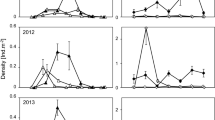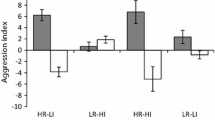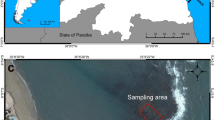Abstract
The grazing fish, ayu, Plecoglossus altivelis Temminck & Schlegel, establishes feeding territorialiry during the young stage. The population density fluctuates from year to year by more than a hundredfold, but the determinant of territory size is less well known. The feeding territoriality of ayu was examined under simulated habitat conditions where fish density was manipulated and food resources were renewable. Fish competed for algae attached to the substrata and were divided into residents with territories, and floaters without territories. By experimental alteration of fish density the number of residents increased with density and rerritory size decreased with density. Floaters intruded into territories in a school to feed on algae, which induced overt aggression of the resident and reduced the productivity of algae growing there. Both the intruding frequency of floaters over territorial areas and their feeding pressure on algae increased at higher floater density. Floaters functioned to shift cost-benefit relationships for various territory sizes. They acted as food competitors to restrict territory size below a maximum through competitive interference. Although the growth rate of residents was inversely related to fish density, residents grew faster than floaters in each group. Under a given set of competitor abundances, economic defensibility determined territory size.
Similar content being viewed by others
References
Alvarez F. (1993) Risks of fighting in relation to age and territory holding in fallow deer. Canadian Journal of Zoology 71: 376–383.
Azuma M. (1964) The life history of the landlocked ayu-fish (Plecoglossus altivelis) in the Lake Biwa, with special reference to their developmental stages. Physiology and Ecology, Japan 12: 55–71 (in Japanese with English summary).
Beeching S. C. (1992) Visual assessment of relative body size in a cichlid fish, the oscar, Astronotus ocellatus. Ethology 90: 177–186.
Blanckenhorn W. U. (1992) Group size and the cost of agonistic behavior in pumpkinseed sunfish. Ethology, Ecology and Evolution 4: 255–271.
Brown J. L. (1964) The evolution of diversity in avian territory systems. Wilson Bulletin 76: 160–169.
Busacker G. P., Adelman I. R. & Goolish E. M. (1990) Growth. In: Methods for Fish Biology (eds C. B. Schreck & P. B. Moyle) pp. 363–387. American Fisheries Society, Bethesda.
Davies N. B. (1978) Ecological questions about territorial behaviour. In: Behavioural Ecology (eds J. R. Krebs & N. B. Davies) pp. 317–350. Blackwell Science, Oxford.
Davies N. B. & Houston A. I. (1984) Territory economics. In: Behavioural Ecology (eds J. R. Krebs & N. B. Davies) pp. 148–169. Blackwell Science. Oxford.
Eberhard J. C. & Ewald P. W. (1994) Food availability, intrusion pressure and territory size: an experimental study of Anna's hummingbirds (Calypte anna). Behavioral Ecology and Sociobiology 34: 11–18.
Fausch K. D. (1984) Prontable stream positions for salmonids: relating specific growth rate to net energy gain. Canadian Journal of Zoology 62: 441–451.
Fukami K., Mizunari T., Kubota H. & Nishijima T. (1994) Seasonal changes in water quality and standing stocks of attached microalgae in two rivers of Kochi. Suisanzosyoku 42: 185–197 (in Japanese with English summary).
Furuta Y., Tanaka K. & Ito T. (1977) Periphyton biomass of attached algae and biological estimation of water pollution level using attached diatoms in the Chikuma River and its tributary, Nagano Prefecture. Bulletin of Freshwater, Fisheries Research Laboratory, Japan 27: 63–73 (in Japanese with English summary).
Hamilton W. D. (1970) Selfish and spiteful behaviour in an evolutionary model. Nature 228: 1218–1220.
Hart D. D. (1985) Cause and consequence of territoriality in a grazing stream insect. Ecology 66: 404–414.
Hasegawa M. & Tanemura M. (1986) Ecology of Territory. Tokai University Press, Tokyo (in Japanese).
Hixon M. A. (1980) Food production and competitor density as the determinats of feeding territory size. The American Naturalist 155: 510–530.
Iguchi K. (1991) Visual stimuli causing the aggressive behaviour of ayu, Plecoglossus altivelis. Bulletin of National Research Institute of Fisheries Science, Japan 2: 15–23 (in Japanese with English summary).
Iguchi K. & Yamaguchi M. (1994) Adaptive significance of inter- and intrapopulational egg size variation in ayu, Plecoglossus altivelis. Copeia 1994: 184–190.
Kawanabe H. (1957) Social behaviour and production of a salmon-like fish Plecoglossus altivelis, or ayu, with reference to its population density. Japanese Journal of Ecology 7: 131–137 (in Japanese with English summary).
Kawanabe H. (1970) Social behaviour and production of ayu-fish in the River Ukawa between 1955 to 1969, with reference to the stability of its territoriality. Japanese Journal of Ecology 20: 144–151 (in Japanese with English summary).
Kawanabe H. (1972) An evolutionary aspect of the territoriality of ayu-fish, Plecoglossus altivelis, with the social structure at the southern end of its distribution. Japanese Journal of Ecology 22: 141–149 (in Japanese with English summary).
Knowlton N. & Parker G. A. (1979) An evolutionarily stable strategy approach to indiscriminate spite. Nature 279: 419–421.
Kodric-Brown A. & Brown J. H. (1978) Influence of economics, interspecific competition and sexual dimorphism on territoriality of migrant rufous hummingbirds. Ecology 59: 285–296.
McCarthy I. D., Carter C. G. & Houlihan D. F. (1992) The effect of feeding hierarchy on individual variability in daily feeding of rainbow trout, Oncorhyncus mykiss (Walbaum). Journal of Fish Biology 41: 257–263.
McDowall P. M. (1992) Diadromy: origins and definitions of terminology. Copeia 1992: 248–251.
Mizuno N. & Kawanabe H. (1957) Behaviour of salmon-like fish ayu in an area with closely established territories. Japanese Journal of Ecology 7: 26–30 (in Japanese with English summary).
Moyle P. B. & Baltz D. M. (1985) Microhabitat use by an assemblage of California stream fishes: developing criteria for instream flow determinations. Transactions of the American Fisheries Society 114: 695–704.
Myers J. P., Connors P. G. & Pitelka F. A. (1979) Terrltory size in wintering sunderlings: the effect of prey abundance and intruder density. Auk 95: 551–556.
Nishimura K. & Ando I. (1991) Estimation of growth of attached algae in a river and feeding conditions by ayu. Nippon Suisan Gakkaishi 57: 391–396 (in Japanese with English summary).
Norton M. E., Arcese P. & Edwald P. W. (1982) Effect of intrusion pressure on territory size in black-chinned hummingbirds (Archilochus alexandri). Auk 99: 761–764.
Parker G. A. & Knowlton N. (1980) The evolution of territory size — some ESS models. Journal of Theoretical Biology 84: 445–476.
Rubenstein D. I. (1981) Population density, resource partitioning, and territoriality in the everglades pygmy sunfish Animal Behaviour 29: 155–172.
Schoener T. W. (1968) Size of feeding territories among birds. Ecology 49: 123–141.
Schoener T. W. (1971) Theory of feeding strategies. Annual Review of Ecology and Systematics 2: 102–114.
Stamps J. A. (1992) Simultaneous versus sequential settlement in territorial species. The American Naturalist 139: 1070–1088.
Tachihara K. & Kimura S. (1988) Differences in the height of dorsal fin and body color between territorial and non-territorial ayu, Plecoglossus altivelis, in Lake Ikeda. Nippon Suisan Gakkaishi 54: 55–60 (in Japanese with English summary).
Tanimizu K., Miura T. & Higashi M. (1981) Effect of water movement on the photosynthetic rate of algal community attached to reed stems. Verhandlungen Internationale Vereinigung Limnologie 21: 584–589.
Tricas T. C. (1989) Determinants of feeding territory size in the corallivorous butterflyfish, Chaetodon muticinctus. Animal Behaviour 37: 830–841.
van den Assen J. (1967) Territory in the three-spined stickleback, Gasterosterus aculeatus. Behaviour 16: 1–164.
Verner J. (1977) On the adaptive significance of territoriality. The American Naturalist 111: 769–775.
Author information
Authors and Affiliations
About this article
Cite this article
Iguchi, K., Hino, T. Effect of competitor abundance on feeding territoriality in a grazing fish, the ayu Plecoglossus altivelis . Ecol. Res. 11, 165–173 (1996). https://doi.org/10.1007/BF02347682
Received:
Accepted:
Published:
Issue Date:
DOI: https://doi.org/10.1007/BF02347682




